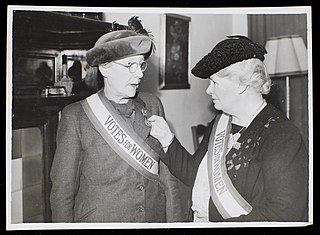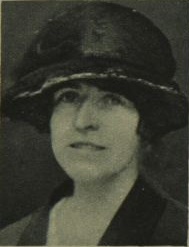Red Clydeside was the era of political radicalism in Glasgow, Scotland, and areas around the city, on the banks of the River Clyde, such as Clydebank, Greenock, Dumbarton and Paisley, from the 1910s until the early 1930s. Red Clydeside is a significant part of the history of the labour movement in Britain as a whole, and Scotland in particular.

A rent strike is a method of protest commonly employed against large landlords. In a rent strike, a group of tenants come together and agree to refuse to pay their rent en masse until a specific list of demands is met by the landlord. This can be a useful tactic of final resort for use against intransigent landlords, but carries the risk of eviction and lowered credit scores in some cases.

Mary Barbour was a Scottish political activist, local councillor, bailie and magistrate. Barbour was closely associated with the Red Clydeside movement in the early 20th century and especially for her role as the main organiser of the women of Govan who took part in the rent strikes of 1915.
The Ellis Act is a 1985 California state law that allows landlords to evict residential tenants to "go out of the rental business" in spite of desires by local governments to compel them to continue providing rental housing.
Rent control in Scotland is based upon the statutory codes relating to private sector residential tenancies. Although not strictly within the private sector, tenancies granted by housing associations, etc., are dealt with as far as is appropriate in this context. Controlling prices, along with security of tenure and oversight by an independent regulator or the courts, is a part of rent regulation.
Rent regulation in England and Wales is the part of English land law that creates rights and obligations for tenants and landlords. The main areas of regulation concern,

Helen Crawfurd was a Scottish suffragette, rent strike organiser, Communist activist and politician. Born in Glasgow, she was brought up there and in London.

Agnes Johnston Dollan MBE, also known as Agnes, Lady Dollan, was a Scottish suffragette and political activist. She was a leading campaigner during the Glasgow Rent Strikes, and a founding organiser of the Women's Peace Crusade. In 1919, she was the first woman selected by the Labour party to stand for election to Glasgow Town Council, and later became Lady Provost of Glasgow.
Mary Laird was a founding member and first President of the Glasgow Women's Housing Association, a President of the Partick Branch of the Women's Labour League, associated with the Red Clydeside movement, and supported the Glasgow Rent Strikes of 1915 alongside Mary Barbour, Agnes Dollan, Mary Jeff and Helen Crawfurd. Laird went on to participate in wider social activism for women and children's rights.

The Increase of Rent and Mortgage Interest Act 1915 is an Act of the Parliament of the United Kingdom which restricted increases in rent and the rate of mortgage interest during World War I. The Act was in place on 25 November 1915 with its restrictions retrospectively in place from 4 August 1914.
South Govan Women's Housing Association was established in 1915 under the leadership by Mary Barbour in Govan on the south side of Glasgow in Scotland.
Glasgow Women's Housing Association (GWHA) was established in Glasgow, Scotland, in mid-1914 by the Independent Labour Party Housing Committee launched by Andrew McBride in 1913 and the Women's Labour League in reaction to the increasing rent prices and overcrowding exacerbated by the advent of the First World War.

Eviction in the United States refers to the pattern of tenant removal by landlords in the United States. In an eviction process, landlords forcibly remove tenants from their place of residence and reclaim the property. Landlords may decide to evict tenants who have failed to pay rent, violated lease terms, or possess an expired lease. Landlords may also choose not to renew a tenant's lease, however, this does not constitute an eviction. In the United States, eviction procedures, landlord rights, and tenant protections vary by state and locality. Historically, the United States has seen changes in domestic eviction rates during periods of major socio-political and economic turmoil—including the Great Depression, the 2008 Recession, and the COVID-19 pandemic. High eviction rates are driven by affordable housing shortages and rising housing costs. Across the United States, low-income and disadvantaged neighborhoods have disproportionately higher eviction rates. Certain demographics—including low income renters, Black and Hispanic renters, women, and people with children—are also at a greater risk of eviction. Additionally, eviction filings remain on renters' public records. This can make it more difficult for renters to access future housing, since most landlords will not rent to a tenant with a history of eviction. Eviction and housing instability are also linked to many negative health and life outcomes, including homelessness, poverty, and poor mental and physical health.

Mary Jeff (1873–1941) was a Scottish activist and politician who was involved in the Glasgow rent strike.
A tenants union, also known as a tenants association, is a group of tenants that collectively organize to improve the conditions of their housing and mutually educate about their rights as renters. Groups may also lobby local officials to change housing policies or address homelessness. As of 2018, in the United States, two states and D.C provide significant rights to tenant unions, and twenty-nine other states provide legal protections to tenant union organizing.
Jessie Fergusson was a Scottish suffragette. She played an active role in the rent strike and was the secretary of the Glasgow branch of The Worker’s Suffrage Federation when it first was established.

The Cost of Living (Scotland) Act 2022 is an Act of the Scottish Parliament which came into force on 27 October 2022.

The 1907 New York City rent strike or the East Side rent strike lasted from December 26, 1907, to January 9, 1908. The rent strike began in response to a proposed rent increase in the wake of the Panic of 1907 which saw tens of thousands unemployed. It began in the Lower East Side and the predominant organizers were Jewish immigrant women in the neighborhood such as Pauline Newman, who played a major role in organizing the strike. It eventually spread to other areas of Manhattan and Brooklyn, comprising approximately 10,000 tenants. The strike was taken over by the Eight Assembly District of the Socialist Party of America in early 1908. Due to mass evictions and police brutality, the strike was broken, though approximately 2,000 successfully halted rent increases.

The 1918-1920 New York City rent strikes were some of the most significant tenant mobilizations against landlords in New York City history. Prior to the strikes, a housing shortage caused by World War I exacerbated tenant conditions, with the construction industry being redirected to war time efforts. In addition, the new defense jobs available attracted thousands of new families to the city, further driving property vacancy rates down. Under these conditions overcrowding, poor conditions, frequent raising of rents and speculation by landlords were common. These long term circumstances, and a nationwide coal shortage, which culminated in a dangerous heating crisis for tenants, would become the catalysts for the subsequent organizing and wave of rent strikes across the city.

The 1904 New York City rent strike was the first mass rent strike in New York City. It took place in the Lower East Side in the Spring of 1904, spreading to 2,000 families across 800 tenements and lasting nearly a month. The strike was a response to proposed rent increases amid a housing shortage. It was primarily organized by local Jewish immigrant women with organizational strategies and language learned from the 1902 kosher meat boycott and the history of labor organizing in the area. Tenant organizers, socialists, and local labor unions united as the New York Protective Rent Association; women who had initially organized the strike such as Bertha Liebson were removed from leadership positions. The strike was successful in the short term, halting the majority of proposed rent increases for the following year. However, landlords began raising rents again a year later, leading to the 1907 New York City Rent Strike.











